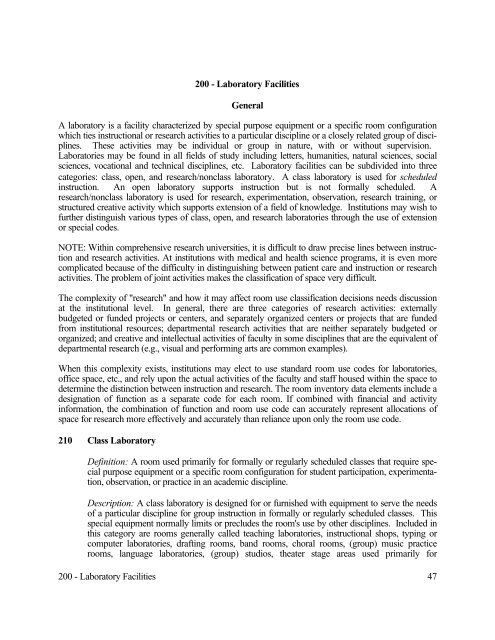Room Use Codes & Definitions
Room Use Codes & Definitions
Room Use Codes & Definitions
Create successful ePaper yourself
Turn your PDF publications into a flip-book with our unique Google optimized e-Paper software.
200 - Laboratory FacilitiesGeneralA laboratory is a facility characterized by special purpose equipment or a specific room configurationwhich ties instructional or research activities to a particular discipline or a closely related group of disciplines.These activities may be individual or group in nature, with or without supervision.Laboratories may be found in all fields of study including letters, humanities, natural sciences, socialsciences, vocational and technical disciplines, etc. Laboratory facilities can be subdivided into threecategories: class, open, and research/nonclass laboratory. A class laboratory is used for scheduledinstruction. An open laboratory supports instruction but is not formally scheduled. Aresearch/nonclass laboratory is used for research, experimentation, observation, research training, orstructured creative activity which supports extension of a field of knowledge. Institutions may wish tofurther distinguish various types of class, open, and research laboratories through the use of extensionor special codes.NOTE: Within comprehensive research universities, it is difficult to draw precise lines between instructionand research activities. At institutions with medical and health science programs, it is even morecomplicated because of the difficulty in distinguishing between patient care and instruction or researchactivities. The problem of joint activities makes the classification of space very difficult.The complexity of "research" and how it may affect room use classification decisions needs discussionat the institutional level. In general, there are three categories of research activities: externallybudgeted or funded projects or centers, and separately organized centers or projects that are fundedfrom institutional resources; departmental research activities that are neither separately budgeted ororganized; and creative and intellectual activities of faculty in some disciplines that are the equivalent ofdepartmental research (e.g., visual and performing arts are common examples).When this complexity exists, institutions may elect to use standard room use codes for laboratories,office space, etc., and rely upon the actual activities of the faculty and staff housed within the space todetermine the distinction between instruction and research. The room inventory data elements include adesignation of function as a separate code for each room. If combined with financial and activityinformation, the combination of function and room use code can accurately represent allocations ofspace for research more effectively and accurately than reliance upon only the room use code.210 Class LaboratoryDefinition: A room used primarily for formally or regularly scheduled classes that require specialpurpose equipment or a specific room configuration for student participation, experimentation,observation, or practice in an academic discipline.Description: A class laboratory is designed for or furnished with equipment to serve the needsof a particular discipline for group instruction in formally or regularly scheduled classes. Thisspecial equipment normally limits or precludes the room's use by other disciplines. Included inthis category are rooms generally called teaching laboratories, instructional shops, typing orcomputer laboratories, drafting rooms, band rooms, choral rooms, (group) music practicerooms, language laboratories, (group) studios, theater stage areas used primarily for200 - Laboratory Facilities 47
















